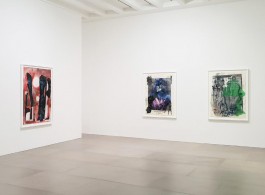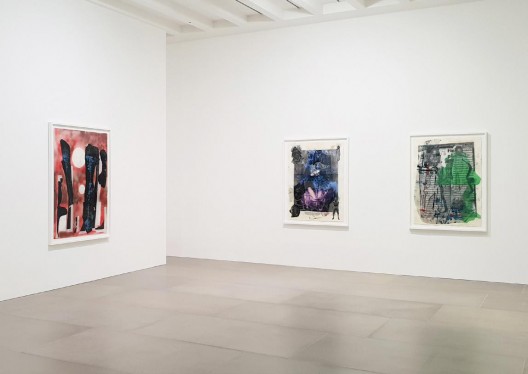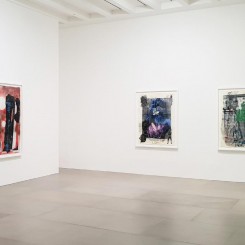Relatives
Moshekwa Langa
Moshekwa Langa is known for a practice that manifests in virtually every medium. He brings his freewheeling process of loose association to Blain|Southern London this summer, in an exhibition that focusses on his painting and collage.
The work here is largely informed by questions around belonging and the artist抯 own identity. He has been living in Amsterdam since 1997, having grown up in the homeland of Kwa_Ndebele, a semi-independent country in South Africa, which was set aside for black inhabitants during apartheid. Throughout the late 1980s and 1990s, however, Langa boarded at a Steiner school near Pretoria with a diverse racial mix of international students. Upon leaving he began to develop a distinctive artistic voice that referenced his contradictory social experiences and distilled the preconceived expectations of him as a black South African artist. His early-career assemblages comprised materials at his immediate disposal, initially made and presented in his mother抯 backyard but quickly achieving international attention at biennials in Istanbul, Havana, S鉶 Paulo, Gwangju and Venice.
The title, Relatives, refers to the Langa’s choice to engage more readily with his work than with familial relationships, which are made more complex through geographic separation. The artist’s dislocation intensified as his career developed overseas and he struggled to connect disparate aspects of his life. It was symbolic that he wasn’t even able to point towards his homeland, which for years was absent from official maps of the fragmented sub-continent.
Borders and boundaries recur within the works in this exhibition, as do rifts and fissures. Langa’s large monochrome paintings on transparent polythene evoke topographical surveys, with meandering valleys cut through by streams of pure colour. Connections to his teenage hometown, KwaMhlanga, can also be interpreted within these works. The long bus route to the white-controlled industries of Pretoria was a twice-daily necessity for the working population in this undeveloped region. Since the discovery of a platinum belt, however, the landscape and economy of the town have changed dramatically.
In his earlier paintings, Langa disfigured official maps in order to impose his personal mythology. He carries this aesthetic over into works on paper here, which explore rippling, subtle changes of tone. This emphasis on colour is significant in all of Langa’s work, which carries inseparable associations with race and nationhood, but also with the colour theories of Steiner education.
Colour, boundaries and linear networks are more subtly evident in Langa’s collages. These comprise layers of newsprint and found imagery, often pixelated and distorted beyond recognition. Abstract patterns and figurative images are painted and drawn within the layers, often adorned by strips of adhesive tape and studio detritus. For Frieze magazine, the critic Sean O‘Toole recommends a ‘curious disassembly’ of Langa’s work, yet he suggests that classifying the material forms is irrelevant. ‘I am simply producing things’ says the artist, ‘if I had to explain what I do to someone, I would say I make kind of dreamscapes…I try to record aspects of waking and sleeping time’. He goes on to describe his practice as ‘making sense of what is around me, and what I imagine and hope to be around me and what I wish to be away from me.’



